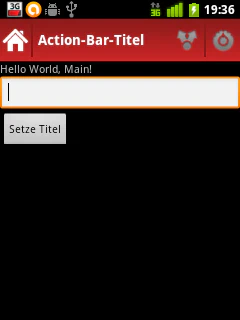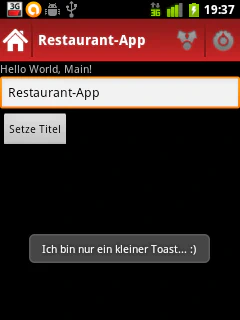Einfache Android ActionBar Programmieren
Dieser Artikel ist bereits über 3 Jahre alt. Die Inhalte sind wahrscheinlich bereits überholt und nicht mehr aktuell.
Eine ActionBar ist immer eine gute Wahl um dem Benutzer eine einfache Möglichkeit zu bieten, durch die App zu navigieren. Doch leider ist diese Funktion erst ab Android 3.0 eingebaut. Daher gibt es folgende Basic-Alternative für alle Android-Versionen!
Hinweis: Hier finden Sie eine bessere Alternative mit ActionBarSherlock und HoloEverywhere zu diesem Artikel.
Vorbereitung
In einem neuen oder auch bestehendem Projekt wird einfach die actionbar.xml Datei im Layout-Ordner erstellt:
<?xml version="1.0" encoding="utf-8"?>
<LinearLayout
xmlns:android="http://schemas.android.com/apk/res/android"
android:orientation="vertical"
android:layout_width="fill_parent"
android:layout_height="fill_parent"
android:scrollbars="vertical">
<LinearLayout
xmlns:android="http://schemas.android.com/apk/res/android"
android:id="@+id/buttonlayout"
android:orientation="horizontal"
android:layout_width="fill_parent"
android:layout_height="wrap_content"
android:height="45dip"
android:gravity="left|top"
android:background="@drawable/actionbar_background"
android:paddingTop="5dp"
android:paddingBottom="5dp">"
<LinearLayout
xmlns:android="http://schemas.android.com/apk/res/android"
android:id="@+id/buttonlayout2"
android:orientation="horizontal"
android:layout_height="wrap_content"
android:gravity="left|center_vertical"
android:layout_gravity="left"
android:layout_width="wrap_content">
<Button
android:id="@+id/actionbarHome"
android:layout_marginRight="1dp"
android:layout_marginLeft="0dp"
android:layout_width="40dp"
android:layout_height="40dp"
android:background="@drawable/ic_home" />
<LinearLayout
android:id="@+id/linearLayout1"
android:layout_width="2dp"
android:layout_height="45dip"
android:orientation="horizontal"
android:background="# 8B1A1A" >
</LinearLayout>
<TextView
android:id="@+id/actionbarTxt"
android:layout_width="fill_parent"
android:layout_height="fill_parent"
android:textStyle="bold"
android:text="Meine ActionBar"
android:textColor="# FFFFFF"
android:textSize="18sp"
android:gravity="center_vertical"
android:paddingLeft="7dp">
</TextView>
</LinearLayout>
<LinearLayout
xmlns:android="http://schemas.android.com/apk/res/android"
android:id="@+id/buttonlayout2"
android:orientation="horizontal"
android:layout_height="wrap_content"
android:gravity="right"
android:layout_gravity="right"
android:layout_width="fill_parent">
<Button
android:id="@+id/actionbarFunk1"
android:layout_width="45dp"
android:layout_height="45dp"
android:background="@android:drawable/ic_menu_share">
</Button>
<LinearLayout
android:id="@+id/actionbar_seperator_funk"
android:layout_width="2dp"
android:layout_height="45dip"
android:background="# 8B1A1A"
android:orientation="horizontal" >
</LinearLayout>
<Button
android:id="@+id/actionbarFunk2"
android:layout_width="45sp"
android:layout_height="45dp"
android:background="@android:drawable/ic_menu_preferences">
</Button>
</LinearLayout>
</LinearLayout>
</LinearLayout>
Damit der Hintergrund der ActionBar auch gut aussieht, wird eine actionbar_background.xml Datei im Drawable-Ordner erstellt. Sie beinhaltet die Farbwerte, die als Hintergrund dienen.
<?xml version="1.0" encoding="utf-8"?>
<shape xmlns:android="http://schemas.android.com/apk/res/android"
android:shape="rectangle">
<gradient
android:startColor="# 8B1A1A"
android:endColor="# CD2626"
android:angle="-90" />
</shape>
Nun wird noch das Home-Icon in diesen Ordner kopiert (heißt ic_home.png).
In Ihre App einfügen
Nun ist die ActionBar schon fast fertig eingerichtet. Sie muss nur noch mit folgendem Code in ein bestehendes Layout eingebunden werden:
<include
android:layout_width="match_parent"
android:layout_height="wrap_content"
layout="@layout/actionbar" />
Einen eventuellen Fehler, dass es Probleme mit dem Layout gibt, sobald man in den visuellen Editor umschaltet, kann man ignorieren, die ActionBar funktioniert trotzdem ohne Probleme.
Im Manifest sollten Sie nun noch als Style Theme.NoTitleBar einstellen, um Android-Versionen ab Version 3.0 die Anzeige der eigenen ActionBar zu verbieten:
<?xml version="1.0" encoding="utf-8"?>
<manifest xmlns:android="http://schemas.android.com/apk/res/android"
package="de.menzerath.actionbar.tutorial"
android:versionCode="1"
android:versionName="1.0" >
<uses-sdk android:minSdkVersion="6" android:targetSdkVersion="10"/>
<application
android:icon="@drawable/ic_launcher"
android:label="@string/app_name" >
<activity
android:name=".Main"
android:label="@string/app_name" android:theme="@android:style/Theme.NoTitleBar">
<intent-filter>
<action android:name="android.intent.action.MAIN" />
<category android:name="android.intent.category.LAUNCHER" />
</intent-filter>
</activity>
</application>
</manifest>
Aktionen festlegen
Nun müssen Sie nur noch in der Activity die ActionBar ansprechen und Aktionen für die Buttons festlegen. In diesem Beispiel sieht das dann folgendermaßen aus:
package de.menzerath.actionbar.tutorial;
import android.app.Activity;
import android.os.Bundle;
import android.view.View;
import android.widget.Button;
import android.widget.EditText;
import android.widget.TextView;
import android.widget.Toast;
public class Main extends Activity {
@Override
public void onCreate(Bundle savedInstanceState) {
super.onCreate(savedInstanceState);
setContentView(R.layout.main);
Button actionbar_home = (Button)findViewById(R.id.actionbarHome);
Button actionbar_funk1 = (Button)findViewById(R.id.actionbarFunk1);
Button actionbar_funk2 = (Button)findViewById(R.id.actionbarFunk2);
final TextView actionbar_title = (TextView)findViewById(R.id.actionbarTxt);
actionbar_funk1.setBackgroundResource(android.R.drawable.ic_menu_share);
actionbar_funk2.setBackgroundResource(android.R.drawable.ic_menu_preferences);
actionbar_title.setText("Action-Bar-Titel");
actionbar_home.setOnClickListener(new View.OnClickListener() {
@Override
public void onClick(View v) {
finish();
}
});
actionbar_funk2.setOnClickListener(new View.OnClickListener() {
@Override
public void onClick(View v) {
einToast();
}
});
actionbar_funk1.setOnClickListener(new View.OnClickListener() {
@Override
public void onClick(View v) {
einToast();
}
});
Button buttonSetTitle = (Button)findViewById(R.id.button1);
final EditText editTitle = (EditText)findViewById(R.id.editText1);
buttonSetTitle.setOnClickListener(new View.OnClickListener() {
@Override
public void onClick(View v) {
actionbar_title.setText(editTitle.getText().toString());
}
});
}
public void einToast() {
Toast toast = Toast.makeText(this, "Ich bin nur ein kleiner Toast...", Toast.LENGTH_SHORT);
toast.show();
}
}
Resultat
Folgendermaßen sollte sich die ActionBar nun verhalten:


Anhang
Folgende Elemente der ActionBar durch die Activity geändert werden:
- Icons des Home-Buttons, der 1. Funktion & der 2. Funktion
- Titel der ActionBar
- Sichtbarkeit aller Elemente
- Aktionen der Buttons
Download
Den kostenlosen Download des gesamten Beispielprojekts finden Sie hier zur freien Verwendung.